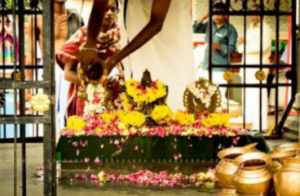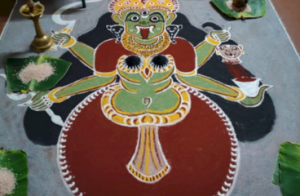About Temple
Chakkulathamma
Chakkulathamma is famously known as the Mother who answers the call of her devotees. Countless pilgrims irrespective of caste creed and colour reach the shrine. The benevolent look of Goddess unfolds a thousand lotus flowers of real bhakthi in the minds of devotees. Chanting of Chakkulathamma’s names and mantras destroys the feelings of ignorance and pride like the flames of fire that overcomes the darkness.
Many are the miracles that we see right in front of the Goddess.
The concept of Goddess which in way is a manifestation of Nature is the supreme symbol of this divinity that shapes us. The Devi at Chakkulathukavu temples is a benign example of the love and motherliness that Almighty showers upon any devotee who seats that inimitable Goddess in his heart.
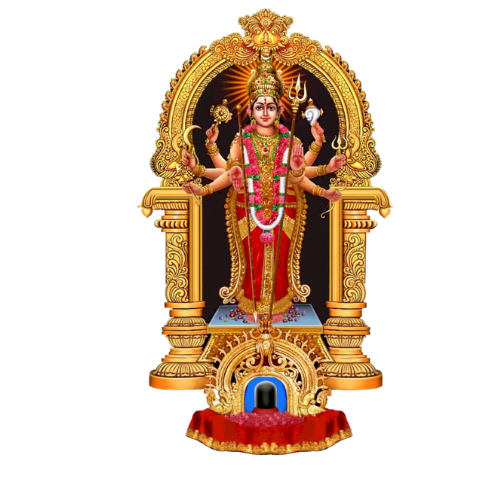

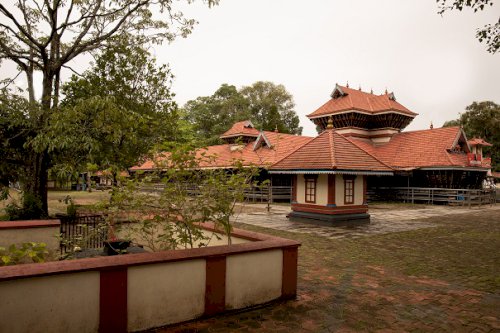
The temple's ancient history is linked to the story of Sumbha and Nishumbha found in the Devi Mahatmyam. These two demons gained immense power through meditation on Lord Brahma. They were granted a boon that only a woman could defeat them, a near-impossible condition. With this advantage, they defeated the Devas, including Indra, and ruled the three worlds. The Devas, helpless, sought refuge in distant forests.
Seeing the Devas' plight, Saint Narada approached his father, Lord Brahma. Brahma explained that life has its ups and downs. There was one solution: the Goddess's power. The Devas began their search for Goddess. They arrived near Himavan, the great King of the mountains, and began chanting potent mantras to please the Goddess. They praised Goddess as the embodiment of power, knowledge, creativity, kindness, and blessings.
Goddess Parvathy heard the Devas' pleas by the Ganga's banks. Feeling their sorrow, another Goddess emerged from within Goddess – an incarnation named Durga. Goddess took a divine form to rescue the Devas from the asuras' troubles.
The story led to a fierce battle between Goddess Durga and the asuras led by Sumbha and Nishumbha. This clash was unparalleled, resulting in the defeat of all the asuras by the Goddess. The Devas regained their powers and prosperity. Sage Narada appeared and praised Durga's invincibility. He explained Goddesswas the cause and witness of the universe's creation, maintenance, and destruction.
It's believed that the Goddess in Chakkulathukavu is a manifestation of this all-encompassing Goddess, Durga.
Let us have a look at the temple history that dates back to almost 3000 years. This area where the temple stands now has been a fearful forest. Trees that seemed to touch the sky, serpents with hissing noises and wild animals in barbaric freedom created and atmosphere one would shudder to think. Rays of the sun failed to look through the trees. Afternoons were like midnights.
Into this forest came a hunter with the idea of collecting firewood. The hunter was not alone. He had his wife and children with him. But everything was so sudden and unexpected. The hunter saw a serpent moving towards him. Its hood was erect and its hissing noise was fearful. Not thinking too much the hunter attacked the snake with his axe.
But the snake was not hurt it only slipped into the forest. An expert in the habits of animals, the hunter knew too well that an attacked snake is dangerous if spared. So he followed it. Searching and searching and still he couldn’t spot out the snake. Finally he reached a lake. It was not much difficult to observe a ‘Chithalputtu’. (A cover of sand made by insects). And what was it that ornamented it like a golden chain? Yes, it was the very snake that he was in search of. Not a second to waste, the hunter thrust his axe again and again upon the serpent. But it was like cutting in the air. Surprisingly the serpent had disappeared.
The hunter had a touch of horror. The next second he saw that the shell upon which the snake coiled was broken. Water was oozing out f it. The hunter watched with awe and wonder. Now there was ‘Akshatham’ (paddy and rice) and ‘Darbha’ (a peculiar type of grass used for pujas). Meanwhile the wife and kids of the hunter joined him. All were spell bound at the unbelievable sight in front of them.
New surprises were to follow. There appeared in front of the hunter a hermit with an inexpressible glow of spirituality. The hermit continued to inform that the very Goddess who is in herself the Mother of the Universe has been residing with full powers inside the shell of sand. He advised the hunter to respectfully break the shell. The statue or image of Goddess was within it. This Goddess was Vanadurga whose worship was sure to shower many fold blessings.
Narada himself broke the shell and took out the statue. The hunter and his family bowed before it. Meanwhile the hermit had disappeared. The hunter brought flowers from the forest, offered garlands and prayed. That night he had a dream and it’s was in this dream that the hunter understood that the hermit was Narada.
As the sun sent down its gentle golden rays in the next morning, many had gathered near the hut of the hunter. They submitted many offerings to the Goddess. Henceforth that place turned out to be a spirituality exceptional one.
The river of time flew gently and continuously. Poojas of the temple were structured systematically. Members of the Illam (Brahmin House) namely Pattamana constructed proper temple. The idol similar to that of Sivalainga, taken out by Narada was installed in the Sanctum sanctorium with all the prescribed ceremonies and Poojas.
Pattamana Illam still stands near at the temple. Members of this family have always been especially dearer to the goddess. Damodaran Namboothiri is the Chief Priest. His childhood days vibrate with powerful reflections of the kindness and blessings of Chakkulathamma.
Everyday there was the “Therali Nyvedyam” (a special sweet preparation of rice and jaggery covered with plantain leaves). During his childhood days Damodaran Namboothiri used to ask for this Nyvedyam to his father. On days when Therali was not available the father told his son at asks the Goddess for Therali and fruits. The innocent child pleaded the Goddess to give him sweet and fruits. Who has really realized the extreme benevolence of the Goddess who in herself is the mother of all living beings! As the child was repeatedly crying for the eatables there was a sound from inside the sanctum sanctorum. Somebody seemed to mention that fruits will soon reach the temple. Wonder of Wonders! Some devotees were seen approaching the temple with basketful of fruits. So intimate was the love of Chakkulathamma to children. This love becomes renowned that parents used to visit the temple with their children. Missing children were soon regained through prayers. Diseases were wonderfully cured. Worship of Chakkulathamma sharpens the intellect of children; The Goddess was adored by all as the phenomenal “The Mother who answers”.
Many places near the temple have derived their original names from the history of the temple. For instance, the water in the historical pond of the temple had the sweetness of jaggery. ‘Chakkarkulam’ became shortened in the long run and came to be known as Chakkulam. ‘Neeru’ in Malayalam means water. Water was absorbed into the sand shell which contained the idol. So the place around the temple came to be called as ‘Neerattupuram’. ‘Puram means place and the word denotes the place which carried and contained the holy water.
The temple was renovated in 1981. The illuminating idol of Vana Durga with the holy eight hands is installed near the original idol. Lord Shiva, Sastha, Vishnu, Vinayaka, Muruka, Yakshi, Serpent Gods and Navagrahas are installed as ‘Upa Devas’.
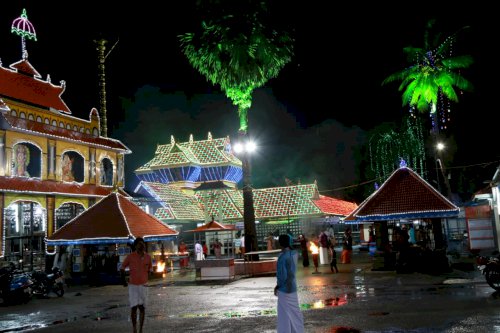
VEERA HANUMAN TEMPLE
The idol of Anjaneya was worshipped in the family for centuries. It was the divine design of the Goddess that a befitting temple be constructed for Anjaneya. Accordingly, a temple was divinely seated and proper poojas as per Tantric rites were established. This temple stands unparallelled and is perhaps a very few of the similar shrines in the whole of Kerala. The idol is unique. It is structured in a single elaborate stone as high as almost 18 feet. It displays the typical marvel of Kerala Temple architecture. The Anjaneya melts down the sorrows of the seekers with graciousness. Anjaneya in Chakkulathukavu is a glowing Diety who offers all types of power and prosperity to the seekers who come to pray.



